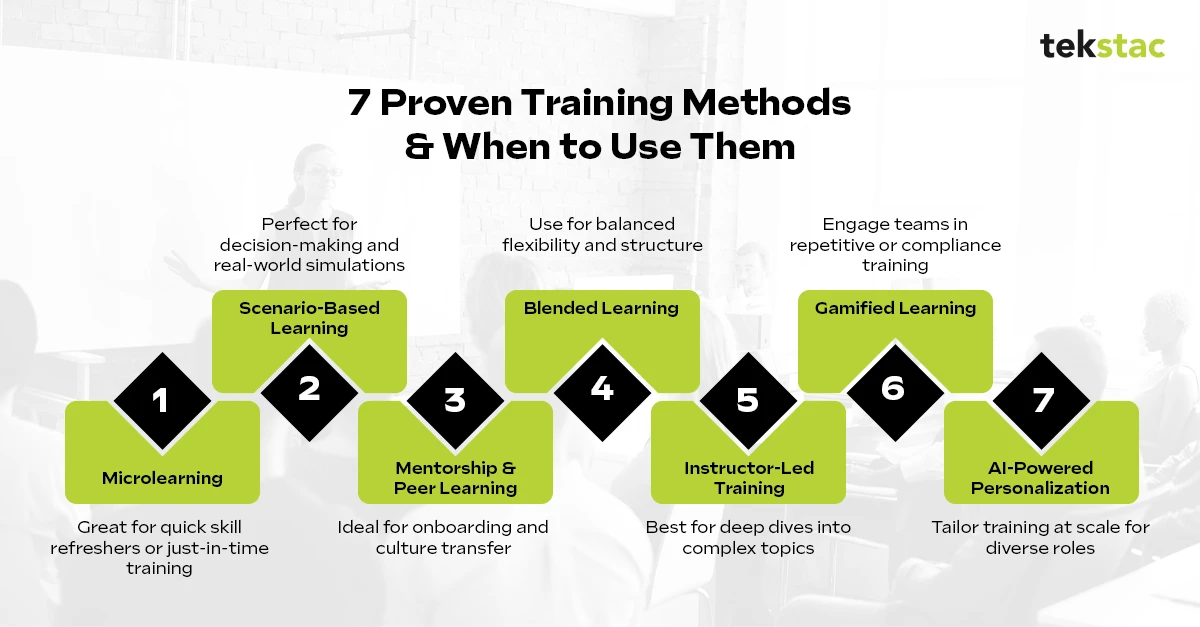7 Employee Training Methods That Actually Work and When to Use

Did you know that companies with strong learning cultures are 92% more likely to innovate and 52% more productive? Training isn’t just a box to tick- it’s a catalyst for growth, agility, and retention.
But here’s the problem: 72% of employees say they don’t get the training they need to succeed in their roles. Why? Because the method doesn’t match the moment.
That’s where strategic, well-timed employee training methods come in.
7 Employee Training Methods That Actually Work and When to Use
- Microlearning: The Employee Training Method for Bite-Sized Brilliance
- Scenario-Based Learning: Experiential Employee Training That Builds Confidence
- Mentorship and Peer Learning: Social Learning Methods That Build Leaders
- Blended Learning: A Flexible Employee Training Method for Modern Workforces
- Instructor-Led Training: Deep Learning for Critical Employee Skills
- Gamified Learning: A Fun and Effective Employee Training Strategy
- AI-Powered Personalized Learning: Smart Training Method for Scalable Growth

1. Microlearning: The Employee Training Method for Bite-Sized Brilliance
What if your team could learn something valuable in the time it takes to grab a coffee?
That’s the promise of microlearning- short, focused learning modules designed to fit seamlessly into the flow of work.
Whether it’s a quick how-to video, a flashcard-based quiz, or a mobile-friendly infographic, microlearning breaks down complex topics into digestible formats that stick. It’s accessible, time-efficient, and perfect for modern learners juggling multiple priorities.
When to Use It:
- For just-in-time learning, like mastering a new tool right before a project
- During onboarding, to prevent information overload
- As refresher modules to reinforce previous training
According to a 2025 report by Gitnux, microlearning can improve knowledge retention by up to 80% over traditional training methods.
2. Scenario-Based Learning: Experiential Employee Training That Builds Confidence
Scenario-based learning places employees in realistic, job-relevant situations that challenge their decision-making, problem-solving, and emotional intelligence. Instead of passive content consumption, learners are required to act and see the consequences of their choices.
Think of a customer service rep navigating a complaint or a healthcare worker handling a patient emergency in a simulated environment. This method makes learning experiential, memorable, and context-rich.
When to Use It:
- For customer-facing teams to build confidence under pressure
- In compliance-heavy industries where decisions carry legal or financial risks
- To train employees in handling conflict, negotiation, or ethical dilemmas
3. Mentorship and Peer Learning: Social Learning Methods That Build Leaders
Sometimes, the best way to learn isn’t through a course- it’s through conversation. Mentorship and peer learning foster organic knowledge transfer, collaboration, and emotional support in the workplace.
Whether it’s a formal mentorship program or casual peer-to-peer learning sessions, this method nurtures a culture of openness, curiosity, and mutual growth. It also builds internal networks and drives retention.
When to Use It:
- When grooming future leaders or high-potential employees
- To help new hires adapt faster by learning from experienced colleagues
- During cultural or organizational transitions, where emotional insight is key
A 2024 report by WorldMetrics.org indicates that companies with structured onboarding programs improve new hire retention by 82%
4. Blended Learning: A Flexible Employee Training Method for Modern Workforces
Blended learning combines the convenience of digital content with the human touch of instructor-led sessions. This approach caters to diverse learning styles- allowing some to learn by watching videos, others through hands-on practice, and still others by engaging in group discussions.
It’s one of the most versatile training methods, ideal for multi-stage learning journeys where theoretical knowledge needs to be paired with real-world application.
When to Use It:
- For large-scale onboarding programs across geographies
- In role-specific certifications or internal promotions
- When rolling out complex systems, tools, or process changes
This hybrid approach ensures consistency without compromising flexibility, an essential trait in hybrid or remote-first workplaces.
5. Instructor-Led Training: Deep Learning for Critical Employee Skills
Despite the digital shift, Instructor-Led Training (ILT) still holds incredible value, especially when the stakes are high. Whether conducted in-person or virtually, ILT brings experts directly to the learners, offering real-time guidance, personalized feedback, and an interactive format.
This method is ideal for collaborative activities like workshops, group roleplay, or troubleshooting sessions. It encourages questions, builds confidence, and fosters team cohesion.
When to Use It:
- For leadership training, soft skills development, or executive coaching
- In industries with strict compliance regulations (e.g., finance, aviation, pharma)
- When launching new tools, systems, or cross-functional initiatives
ILT works best when used strategically, supported by pre-reads or eLearning, followed by post-session exercises or assessments.
6. Gamified Learning: A Fun and Effective Employee Training Strategy
Gamification adds fun, motivation, and healthy competition to training by using elements like badges, points, leaderboards, and progress bars. But beyond just “fun,” gamification taps into intrinsic motivators- such as achievement, status, and recognition.
It’s one of the most engaging employee training methods, particularly effective in building consistency and driving behavior change.
When to Use It:
- For sales and customer service teams to boost energy and competition
- When rolling out repeat training modules like safety or HR policies
- To reinforce learning through simulations or mobile-based quizzes
Gamified platforms can also track learning progress in real time, giving L&D teams valuable data on engagement and gaps.
7. AI-Powered Personalized Learning: Smart Training Method for Scalable Growth
One-size-fits-all training doesn’t work anymore, especially in organizations with diverse roles, career goals, and skill sets. Enter AI-powered personalized learning.
By analyzing an employee’s current skills, behavior, and performance, AI can recommend customized learning paths, adjust difficulty levels, and even predict what topics they’ll need next. It’s like having a personal tutor for every employee, at scale.
When to Use It:
- For large enterprises looking to reskill or upskill across roles
- In digital transformation projects where speed and scalability matter
- For long-term employee growth and career pathing
According to a 2024 report by Virtasant, integrating AI into corporate training programs has led to a 57% increase in learning efficiency, significantly boosting employee productivity.
The Bottom Line: Transform Your Workforce with the Right Employee Training Methods
Organizations that treat training as a strategic tool- not a checkbox- build resilient, skilled, and engaged workforces. They retain top talent, respond to change faster, and outperform competitors.
And it all starts with choosing the right employee training methods for the right moments.
So, the next time you plan a training rollout, ask yourself: Is this the right method for this moment? Because how you train may just determine how far your people, and your company can go.
While we’ve explored specific training methods here, understanding how these fit into a broader organizational strategy is crucial
Discover the bigger picture of how modern organizations are revolutionizing employee training and development – at scale, with speed, and strategic intent.
FAQs on Employee Training Method
1. What is the best training method for strength?
The best method for building strength is progressive resistance training, focusing on gradually increasing weight, intensity, or difficulty over time.
2. How can AI improve employee training methods?
AI enhances training by personalizing learning paths, predicting skill gaps, and providing real-time feedback to boost engagement and retention.
3. Why should companies invest in modern employee training methods?
Modern training methods increase productivity, reduce turnover, and future-proof workforce skills, aligning learning with business goals.
4. Which training method is most effective?
The most effective method depends on goals — but blended and AI-powered learning deliver the best results by combining flexibility with personalization.





